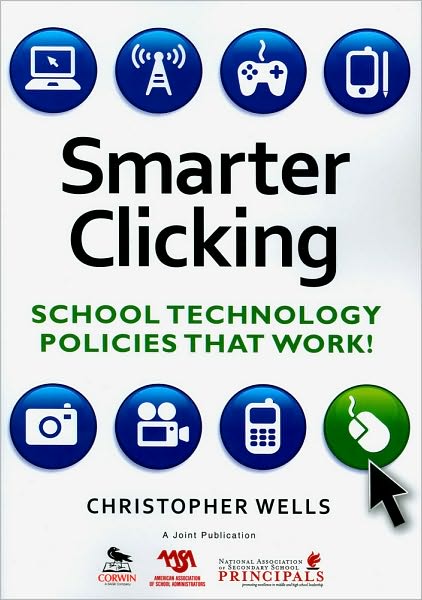
"Technology policies and procedures often suffer from being too limiting or too nebulous, both of which are almost impossible to enforce." With that single statement, Christopher Wells captures, in his book Smarter Clicking: School Technology Policies That Work, the monumental task administrators and technology teams face when trying to develop technology policy. A technology policy that is too limiting hampers teachers and students' efforts to use technology for legitimate instructional purposes. Draconian technology policies serve to keep school systems and schools out of innovation and in the status quo. But even these efforts are akin to trying to plug holes in a dike with the proverbial finger. The dike has actually collapsed and our schools are flooded with iPhones, iPods, netbooks, iPads, and notebook computers, and no matter how much we try to keep them out, "It ain't happening." Smart technology policy according to Wells is flexible but clear.
Early in his book, Wells quotes Bruce Scheier from a book called Computer Crime Hype. "Beware the Four Horsemen of the Information Apocalypse: terrorists, drug dealers, kidnappers, and child pornographers. Seems like you can scare any public into allowing the government to do anything with those four." There is truth in that statement. Oftentimes, much of the efforts to create common-sense technology policy is hampered by the fear-mongering Scheier alludes to in his Four Horsemen of the Information Apocalypse statement. The truth is, developing technology policy is hard work. As Well's points out, it involves balancing three main things: legal requirements, safety of our students and staff, and protection of our school system's technology investment. The legal considerations involve considering stipulations under the Children's Internet Protection Act (CIPA), Family Educational Rights and Privacy Act (FERPA), and the Health Insurance Portability and Accountability Act (HIPAA). Any policy and procedures can't ignore the law, and Wells does a fantastic job in his book outlining all the considerations surrounding each of these. He also goes into great detail about creating policy that addresses the safety of students and staff. One aspect of safety involves preventing our students from divulging too much personal information on the Internet, and the other is protecting them from inappropriate web content. Smarter Clicking provides a comprehensive list of safety considerations for policy makers. In addition to providing valuable information about Internet safety, Wells also provides a complete overview of what areas administrators need to consider when developing policy to protect the school system's investment in technological resources. He provides ideas for controlling access to network resources and for the protection of school system data. Both of these are important components of protecting the district's investment.
While Wells advocates flexibility for technology policy, he also recommends ongoing review of both technology policies and procedures. He suggests that administrators and technology teams get teachers and community members involved in the process of development. Technology policy and procedure development is a process that needs the input of each of these parties.
In the end, Christopher Wells' book is an excellent addition to the 21st century administrator's book shelf. At only 127 pages, it is an excellent starting point for discussions regarding what a technology policy should look like. In almost textbook fashion, he takes you through every single consideration for a "School Technology Policy That Works." While it is not what I would call an entertaining or even thoughtful read, it does provide a comprehensive reference book about school technology policy. It is certainly a book that I will be returning to again and again as we seek to keep technology policy current and workable.
No comments:
Post a Comment